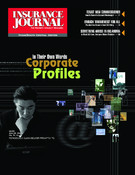Trials and Tribulations in Neverland (Oklahoma)
Almost everyone did something wrong in Neverland-Neverland, Oklahoma, that is.
This story begins and ends in the District Court of Neverland-where a mock trial put on by the Independent Insurance Agents of Oklahoma proved that when it comes to errors and omissions, everything that could go wrong often does and determining who’s at fault is no easy task.
The E&O trial in question took place in Oklahoma City during IIA Oklahoma’s Hypopanty and Legislative Day event. The key players were independent agent Carla Carefree, her longtime customer, Glen Hogan of Hogan Golf Ltd., and the No Way Insurance Com-pany. What started out as a routine change on a property policy turned into a nightmare for the fictional agent, insured and insurance company alike, as the case was a perfect example of how not to conduct business.
Glen Hogan, a golf equipment supplier, charged into Carla Carefree’s office one day and told her he needed insurance for a newly purchased historic warehouse, in which he intended to store some of his company’s inventory of golf equipment. “Go ahead and take care of it. You know exactly what I want,” he told Carefree.
He was in a hurry and had no time for small talk, so Carefree wrote a few notes on a paper napkin and told Hogan it “will be taken care of as usual.” Hogan swept out of the office and Carefree handed the napkin to her CSR, Betty Busy, telling her to place a change order.
Fifteen days later Hogan’s $125,000 warehouse burned to the ground. Hogan hurried into Carefree’s office to report the claim. Again, Carefree told her client-no problem, it will be taken care of. However, when she called the underwriter at No Way Insurance Company, a carrier with which she was authorized to write business and did so routinely, she was told, well, ‘no way-there’s no insurance in place to cover Hogan’s new property.’
Still, while denying the existence of coverage, the underwriter, Lonny Longgone, instructed an adjuster, Sammy Sleuth, to check out the claim. Mr. Sleuth proceeded to Carefree’s office and demanded to see Hogan’s file, and the agent gave it to him. He saw that the order was never sent to the insurance company and went off, taking the file with him. Later, when questioned at trial, Longgone (who by that time was indeed long gone to the Benevolent Insurance Company of Lake Placid, N.Y.) as to why he sent an adjuster when there was no coverage in place, he answered that it was “standard procedure.”
With the insurance company denying the claim and Carefree unable to convince them otherwise, Hogan was left holding the bag for the cost of his burned-down warehouse. Naturally, he sued both Carla Carefree, for being negligent in failing to obtain insurance, and No Way Insurance Company, for denying coverage.
No Way, insisting there was no way it was at fault, filed a third party claim against Carefree, so that in the event it was required to pay Hogan Golf for the warehouse, it could go after Carefree for reimbursement. Even if Carefree had submitted the order, which she did not, No Way claimed at 10,500 square feet the warehouse exceeded the square footage for which Carefree was authorized to bind insurance on her own.
At trial Carefree and her lawyer insisted that coverage was bound even though the warehouse burned down before the insurance company knew about its existence. Carefree claimed she’d often post-dated coverage orders and placed insurance for buildings that exceeded the 10,000 square feet she was authorized to insure. Lonny Longgone, the underwriter at No Way with whom Carefree often worked, had routinely made exceptions when it came to accepting risks, Carefree said. In short, she assumed the coverage was in place.
No Way’s lawyer maintained that the company was “not responsible for the acts of Carefree Insurance Agency” and that Carefree had no right to bind this coverage for No Way. In addition, the company was not notified about the building until a claim was filed and no coverage was ever bought or bound for it.
Carefree’s lawyer responded that Betty Busy had in fact typed up the change order (even though she didn’t send to the insurance company) and by contract the agency had authority to bind coverage on risks up to 10,000 square feet. Since No Way had made exceptions in the past it was assumed it would in this case. “Lonny always accepted our submissions with no problems,” Carefree said. For his part, Longgone admitted that he had made exceptions for Carefree before.
Carefree had been Hogan’s insurance agent for 10 years; and while No Way insisted that, as an independent agent Carefree “was not an employee of No Way Insurance Company,” she had had an agency agreement with the company for
20 years.
In his summarization, Carefree’s lawyer pointed out that during the 10 years Hogan Golf had been Carefree’s client, it had been an “extremely good risk there was absolutely no indication that No Way Insurance Company would refuse to provide coverage on the warehouse. All that happened in this case is that my client inadvertently failed to forward the change order to the insurance company. If she had done so before the fire there would be no question that the insurance company would be responsible for the loss.” The lawyer concluded that the insurance company was simply trying to back out of its obligations.
The case was then turned over to the jury-the audience of independent insurance agents.
In briefing the agent-jury, Tom Cooper, attorney for the IIA Oklahoma (who also acted as Carefree’s lawyer), said if this had been a real jury trial, the judge would have read to them the Oklahoma law pertaining to the case.
The judge, who was in fact retired Oklahoma Supreme Court Justice Don Barnes, noted that while juries would follow the law, they would also use common sense in trying to determine who was at fault. Barnes added that what was interesting in the case was the question of which parties were negligent, since all of them did something wrong. While it would be up to the jury to decide who the liability falls on, he said, “the thing you need to learn from this case is how not to do business.”
Cooper explained that most cases like the Carefree/Hogan/No Way case don’t go to trial; they reach a settlement. Usually the company and agency would contribute some to the settlement. But in a jury trial, the jury would have to find against one party or another-either the insurance company or the agency would be assigned fault. If the insurance company were found to be responsible for the claim, it would likely then go after the insurance agency
for reimbursement of all or part of the money.
In the end, the jury of Carla Carefree’s peers found that No Way Insurance Company should have provided coverage and was responsible for the claim.
With the insurance company denying the claim and Carefree unable to convince them otherwise, Hogan was left holding the bag for the cost of his burned-down warehouse.
Was this article valuable?
Here are more articles you may enjoy.


 Allstate Can Proceed With Recovery in Texas RICO Case: Fifth Circuit
Allstate Can Proceed With Recovery in Texas RICO Case: Fifth Circuit  Experian: AI Agents Could Overtake Human Error as Major Cause of Data Breaches
Experian: AI Agents Could Overtake Human Error as Major Cause of Data Breaches  Business Moves: ALKEME Expands in US With Addition of 5 Agencies
Business Moves: ALKEME Expands in US With Addition of 5 Agencies  Update: Verizon Says Service Restored After Thousands Affected by Outage
Update: Verizon Says Service Restored After Thousands Affected by Outage 


